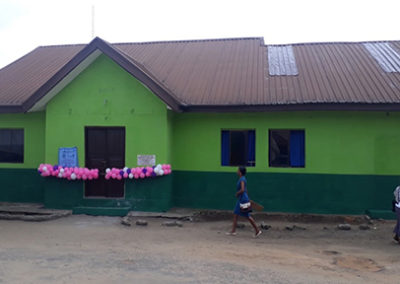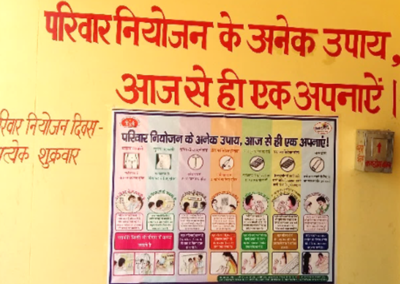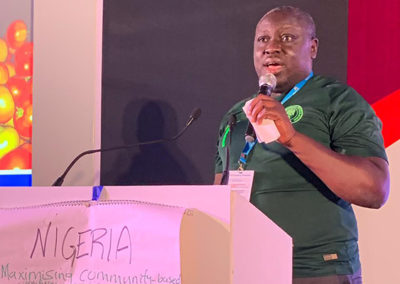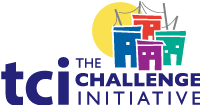TCI Global Toolkit: Service Delivery
Facility Makeovers- Home
- Help and Support
- Close
- Toolkits
- Global Toolkit
- AYSRH Toolkit
- Hub Toolkits
- Core High-Impact Practices
- Gender Essentials Mini Course
- Close
- Resource Collection
- Community of Practice
- Coaching
- Log In/Register
- My Profile
- English
What Is It?
A facility makeover is not a capital investment; it is improving the physical environment of clinics or other facilities that provide family planning services to urban poor populations. A collaborative effort between the local government, the communities that the facility serves and TCI, 72-hour makeovers are a cost-effective way to promote family planning and foster community ownership of the health facility. Specific repairs and renovations are determined based on priorities identified as part of a facility assessment. During the makeover, facilities are renovated, refurbished and equipped for optimal family planning service provision. By engaging the community and local artisans and vendors throughout the makeover process, the facility makeover also becomes a mental makeover restoring the community’s confidence in the facility and its services.
What Are the Benefits?
- Renovating facilities that are in disrepair or poorly equipped encourages clients to seek family planning services at the facilities
- Ensuring the availability of basic equipment and supplies and creating a friendly, clean environment enables providers to work more effectively and take pride in their workplace
- Seeing a dramatic change in a short time creates excitement among the community and inspires clients to seek services. In addition, due to the community involvement throughout the process, the facility makeover enshrines a sense of community pride and ownership

Before and after photos from a 72-hour makeover in Bauchi State, Nigeria.
Nigeria
TCI Nigeria adapted or right-sized the Nigerian Urban Reproductive Health Initiative’s (NURHI’s) nine- step proven 72-hour clinic makeover approach, which often took 4-6 months of planning and implementation, shortening the time to just 4-5 weeks by refining the process so multiple steps can be carried out simultaneously. This approach has been hailed by state government stakeholders, facility providers and community members as a game changer.
East Africa
In East Africa, Tupange Pamoja adapted the from Nigeria 72-hour clinic makeover approach. Facility makeovers have been conducted in 3-5 weeks in Uganda, and usually includes demand generation activities such as household visits and community announcements, and an in-reach to provide family planning services on the day the newly renovated facility is commissioned. Learn more about the experience from Wakiso District.
How to Implement?
TCI Nigeria adapted the Nigerian Urban Reproductive Health Initiative’s (NURHI’s) nine-step proven 72-hour facility makeover approach, which often took 4-6 months previously to prepare for the 72-hour transformation to 4-5 weeks. Learnings from TCI Nigeria implementation has led to the refinement of this process in which multiple steps can be carried out within each week. This adapted process is being scaled up in 10 states across Nigeria.
Week 1: Engage Stakeholders & Select Sites
Stakeholder engagement
Map out the key stakeholders in your geography. Identify the decision-makers that require buy-in. Convene joint meetings with all relevant government officials, including Ministry of Health and local government to:
- Introduce them to the activity and the processes entailed
- Discuss the proposed timelines and start planning for commissioning of the facility, which happens the Monday post-weekend makeover
- Identify staff needed to facilitate the process
- Introduce the assessment process planned for week 2 and agree with the stakeholders on the mode for disseminating the assessment findings – which can be through a presentation at an upcoming contraceptive technology update meeting or other planned meetings, by circulating printed versions of the assessment or sending it out via email. The dissemination must take place at the end of week 2 or the beginning of week 3 at the latest.
Site selection
Identify high-volume sites and agree with government stakeholders on how facilities among the high volume sites will be selected for makeovers. Facilities can be prioritized based on existing and potential client volume and poor infrastructure, especially in terms of lack of privacy for family planning clients, which can affect client volume and result in poor uptake of family planning services. Once sites are selected, meet with Medical Directors, family planning providers, and providers at integration points (e.g., labor ward, antenatal clinic, postnatal clinic, post-abortion care units, immunization units and HIV units) of the selected sites at the facility and introduce them to the activity and what all is required.
Week 2: Conduct Assessment & Identify Artisans and Vendors
Conduct assessment
Whenever possible, use existing meetings with the facility’s Health Management Team and the Quality Improvement Team (QIT), if it is already established, as well as Health Management Information System (HMIS) and Reproductive Health/Family Planning (RH/FP) officers to debrief them on and engage them in the assessment process to avoid incorrect assumptions about the state of family planning facilities and their use and highlight areas that need to be strengthened.
Plan to conduct the assessment, such as a Performance Improvement Assessment, in two days. Visit health facilities and conduct the assessment to identify items needing repair and supplies needing replacement. With health facility staff, prepare a prioritized list of renovations, repairs and improvements for each facility. Where possible, use Open Data Kit (ODK) – an open source software – to record and share the findings. Prepare a brief one-pager on the key highlights per facility to communicate to policymakers.
Identify and recruit artisans and vendors
Concurrently, engage with local stakeholders, such as the facility’s QIT team, to generate a pool of artisan and vendors from the catchment area of each high-volume site.
Week 3: Orient Artisans, Develop SOW & Budget and Engage the Community
Orient artisans
Orient artisans on the types of family planning services offered at the facility, the planned renovations as determined by the assessment and the expected quality of work by sharing with them photos from previous makeovers conducted at other facilities.
Develop scope of work (SOW) and budget for the makeovers
Based on the findings from the assessment, prepare an action plan and timeline for each facility makeover (i.e.,batching the facilities for makeover). This is where the pool of artisans generated in week 2 are engaged together with the QIT by the assessors to agree on the actual work to be carried out in each facility. Work with the artisans to get quotations based on the SOW determined for the makeover. The quotations received are used as a guide in developing the budget. A detailed checklist can facilitate coordination of the process, organization of tasks including the commissioning or opening event and assembly of all materials required.
Community engagement
Engage with the community to see how they might be able to contribute to the makeover. This may range from supervision of artisans during implementation to mobilization of in-kind donations and/or coordination of labor, such as of persons to clean the facility environment.
Week 4: Procure Equipment & Furniture
Equipment and furniture purchase and transport
Communicate in advance when you expect the vendors to deliver the equipment and furniture needed for the makeover. Determine where, when and to whom the deliveries should be made. Branding arrangements should be made at this point as well.
Week 5: Implement and Reveal the Makeover
Implement facility makeover
To avoid interrupting weekday services, repairs and renovations are carried out throughout the weekend, beginning at the clinic’s close of business on a Friday. By Monday morning, the clinic reopens in a renewed state, ready to provide optimal family planning services.
Reveal makeover in public event
Hold a public commissioning when the makeover is complete to reveal the improvements; invite a prominent leader to officially reopen the facility. Use the opportunity to promote the services offered at the facility and encourage community leaders to show their support for family planning.
What Is the Evidence?
Nigeria
The proven approach of 72-hour facility makeovers has been implemented across 10 TCI-supported states. In Bauchi State, after TCI-supported makeovers of family planning units in five health facilities, state officials used the approach to renovate other units at three of the facilities. Makeovers are a cost effective way to promote family planning services and foster community ownership of the health facilities. This approach is diffused to policymakers, technocrats and other implementing partners, and has been adapted beyond the 10 TCI-supported states as a result. Planned Parenthood Federation of Nigeria (PPFN) adapted the 72-hour makeover approach in 75 facilities in Gombe state in northeastern Nigeria.
East Africa
The 72-hour facility makeover approach has been implemented at several health facilities across Uganda. At one health facility in Uganda, upgrades included fixing broken windows, repairing a non-functioning plumbing system, upgrading the floors, a new coat of paint, new communication materials and a newly designated private area for family planning clients to discuss their options with providers in privacy. The building materials and labor were sourced locally to foster inclusiveness, ownership and sustainability within the community.
Evidence from the Urban Reproductive Health Initiative (URHI)
- Improving family planning facilities was “critical for technical quality and infection prevention, privacy for women, cleanliness and to make the clinic a place that both providers and clients would be willing to spend time in.” (Retrospective Comparative Review, page 43)
- In Nigeria, “NURHI viewed the decrepit facilities as an indicator of the ideas and feelings … of stakeholders, policymakers, the larger community and service providers, specifically that they lacked motivation for and did not value family planning. The solution therefore involved advocacy with local stakeholders, engagement with facility administrators, participation of facility staff in the renovation process (coined as the ‘72-Hour Clinic Makeover’), and a launch of a ‘new and improved’ family planning facility that built support for the providers in their community. It is important to note that the facility renovations generally entailed a coat of fresh paint, scrubbing, connecting a sink to the hospital’s water line, and making sure contraceptive commodities and equipment were on hand—not, in most cases, major costs or construction.” (Krenn et al., 2014)
TCI APP USERS PLEASE NOTE
You will only receive CERTIFICATES by email – when earning a score above 80% – and will not be able to view or print a certificate PDF from the TCI app.
Test Your Knowledge
Earn a Certificate
Quiz Summary
0 of 4 Questions completed
Questions:
Information
You have already completed the quiz before. Hence you can not start it again.
Quiz is loading…
You must sign in or sign up to start the quiz.
You must first complete the following:
Results
Results
0 of 4 Questions answered correctly
Your time:
Time has elapsed
You have reached 0 of 0 point(s), (0)
Earned Point(s): 0 of 0, (0)
0 Essay(s) Pending (Possible Point(s): 0)
Categories
- Not categorized 0%
- 1
- 2
- 3
- 4
- Current
- Review
- Answered
- Correct
- Incorrect
-
Question 1 of 4
1. Question
What are some of the challenges associated with facility makeovers?
-
Question 2 of 4
2. Question
The Nigerian Urban Reproductive Health Initiative (NURHI) ’72-Hour Clinic Makeovers’, in most cases, did not include major costs or construction but rather a coat of fresh paint, scrubbing, connecting a sink to the hospital’s water line, and making sure contraceptive commodities and equipment were on hand. They found that the facility makeovers engaged facility staff to value family planning.
-
Question 3 of 4
3. Question
How do you intend to use the information reviewed and/or tools that you accessed?
-
This response will be awarded full points automatically, but it can be reviewed and adjusted after submission.
-
-
Question 4 of 4
4. Question
How useful did you find the information and/or tools presented on this page? Please write your response in the box below using one of the following phrases: Very useful, Useful, Somewhat useful, Not useful.
Feel free to comment on why you made that choice.
-
This response will be awarded full points automatically, but it can be reviewed and adjusted after submission.
-
Service Delivery Approaches
Watch a Makeover in Action
Helpful Tips
- Some facilities will need more work than others; make separate action plans for each facility.
- If resources are limited, consider doing a basic makeover that includes cleaning and repairs to make existing equipment functional.
- Involve the community in the makeover to encourage a sense of ownership of the facility.
- Batch facilities for makeovers by proximity to ease the burden on those involved in the process as well as allow the opportunity for multiple sites to be commissioned (reopened) on the same day.
- Prepare all supplies and equipment before the makeover begins so you can complete it within the allotted time frame.
- After the makeover, commit to refreshing the facility on an ongoing basis so the tasks are more manageable.
Considerations
- A major facility makeover requires considerable effort. To prevent the need for another major makeover in the near future, continually monitor the facility to ensure equipment and supplies are functioning and available.
- Facility makeovers are only one component of ensuring quality family planning services. You will also need to train providers, ensure strong logistics systems and strengthen leadership and management.









